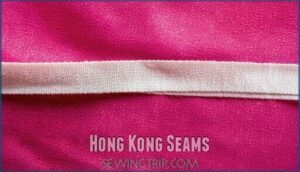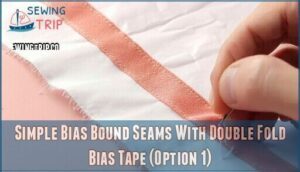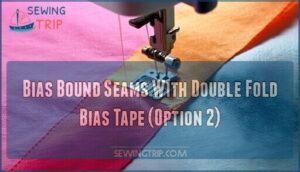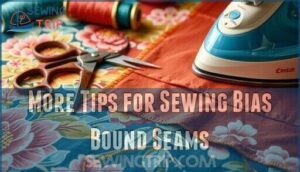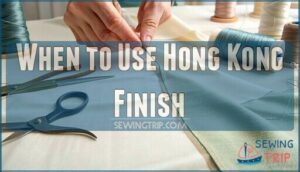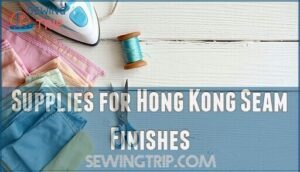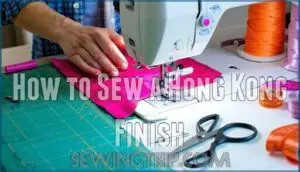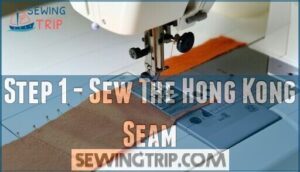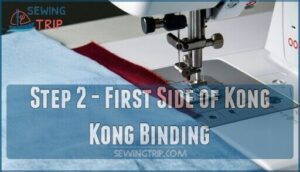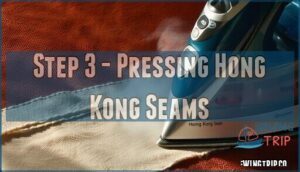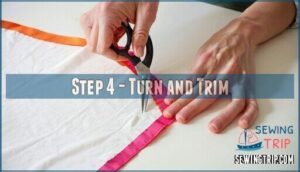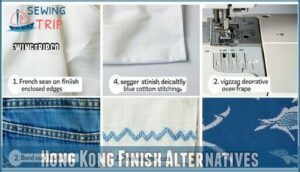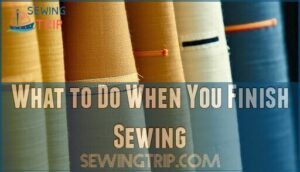This site is supported by our readers. We may earn a commission, at no cost to you, if you purchase through links.
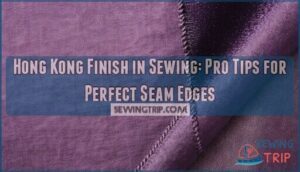 A Hong Kong finish in sewing is a professional seam finishing technique that wraps raw fabric edges with bias tape or bias-cut strips, creating clean, fray-free seams.
A Hong Kong finish in sewing is a professional seam finishing technique that wraps raw fabric edges with bias tape or bias-cut strips, creating clean, fray-free seams.
Named after Hong Kong’s renowned tailors, this method gives your garments that high-end, couture look you’ve been chasing.
You’ll encapsulate each seam allowance individually, which prevents fraying while adding structure and stability.
It’s particularly brilliant for medium to heavyweight fabrics like wool or linen that love to unravel.
While it takes more time than a simple zigzag stitch, the results speak volumes about your craftsmanship.
The secret lies in the precise stitching technique that makes the binding nearly invisible, which is crucial for achieving a professional finish with clean, fray-free seams.
Table Of Contents
Key Takeaways
- You’ll create professional-grade seam finishes by wrapping bias-cut fabric strips around raw edges, preventing fraying while adding that high-end couture look to your garments.
- You should use this technique on unlined garments made from medium to heavyweight fabrics like wool or linen, where interior seams remain visible and need that polished appearance.
- You’ll cut your bias strips 1 to 1.5 inches wide and apply them by sewing right sides together first, then folding over and stitching in the ditch to secure the binding around each seam allowance.
- You can expect your garments to last 40% longer with proper Hong Kong finishing, as this technique adds structural integrity while transforming amateur sewing into professional-quality craftsmanship.
What is a Hong Kong Finish?
A Hong Kong finish is the secret weapon that transforms amateur sewing into professional-grade craftsmanship. This sophisticated seam finish definition involves wrapping raw fabric edges with bias-cut strips, creating an elegant fabric edge binding that prevents fraying while adding visual appeal.
Professional seamwork starts with the details – and Hong Kong finishes turn every raw edge into couture-worthy perfection.
Think of it as giving your seams a bespoke jacket** – the bias strip technique encases rough edges in smooth, lightweight fabric. You’ll cut strips on the bias grain, which allows them to curve gracefully around seam allowances without puckering or pulling.
This sewing technique shines brightest in unlined garment finish applications, where the interior construction becomes visible. Instead of exposed, fraying edges, you’ll create a professional seam look that rivals high-end ready-to-wear clothing.
The Hong Kong finish works particularly well with delicate fabrics like silk, cotton lawn, or voile. When executed properly, this edge finish technique transforms the inside of your garment into something beautiful enough to display – a true mark of couture-level attention to detail.
When done right, your garment’s interior becomes as stunning as its exterior – that’s true couture craftsmanship.
Where is This Technique Best Used?
This professional seam finish shines brightest on unlined garments where every inside detail matters.
You’ll find it particularly valuable on thicker fabrics like wool coats, jackets, and vests where raw edges need taming without adding bulk.
The Hong Kong finish excels with lightweight fabrics such as linen, voile, and silk that tend to fray easily.
It’s your go-to edge finish for delicate fabrics that require gentle handling while maintaining durability.
This technique works beautifully on curved seams like armholes and princess seams, where the bias-cut binding naturally follows the shape.
Consider using this jacket finish on formal wear’s center back seams and zip openings for a couture-like appearance.
It’s also perfect for waistbands, facings, and any seam that’ll be pressed open.
The technique adds visual interest to garment interiors while preventing fraying.
For hard-wearing items, consider that flat felled seams offer a strong and durable alternative.
Mass-produced custom garments from Hong Kong popularized this method, though haute couture has favored it since the 19th century.
Today, it remains the gold standard for achieving a professional finish on quality unlined garments.
The Technique
You’ll master the Hong Kong finish by wrapping bias-cut fabric strips around raw seam edges, creating a clean and professional look inside your garments.
This technique works on both straight and curved seams, and you can choose matching or contrasting fabrics to add your personal touch to the finished piece.
Hong Kong Seams
When you bind each seam allowance separately with bias tape, you’re creating authentic Hong Kong seams.
This sewing technique wraps regular bias tape around raw edges, then you’ll stitch in the ditch to secure everything perfectly.
- Each seam gets individual binding on the wrong side
- Binding stays unturned to reduce bulk compared to traditional bound seams
- Works beautifully for curved seams thanks to bias flexibility
This binding method transforms your fabric selection into couture-quality finishes.
For exposed seams, consider how bias bound seams can add a polished look.
Simple Bias Bound Seams With Double Fold Bias Tape (Option 1)
Ready-made double fold bias tape simplifies this seam finish technique.
You’ll wrap the tape around raw edges, creating a sandwich effect that secures everything in place.
Here’s how different tape widths and fabrics pair together:
| Tape Width | Best Fabric Weight | Application Method | Securing Technique | Final Result |
|---|---|---|---|---|
| 1/2 inch | Lightweight cotton | Wrap snugly | Single stitch line | Clean edge |
| 5/8 inch | Medium weight | Overlap slightly | Double stitch | Secure hold |
| 3/4 inch | Heavy fabrics | Full coverage | Reinforced seam | Professional finish |
| 1 inch | Thick materials | Complete wrap | Strong attachment | Durable edge |
| Custom width | Any weight | Customized fit | Precise placement | Perfect match |
Pre-made bias tape saves time while delivering excellent results for your Hong Kong finish, using a double fold technique to create a clean edge with a professional finish and a secure hold.
Bias Bound Seams With Double Fold Bias Tape (Option 2)
Using pre-made double fold bias tape streamlines your hong kong finish with ready-to-use convenience.
Simply wrap the tape around your seam allowance, ensuring the folded edge hugs the raw fabric edge perfectly.
Stitch along the first folded line of the bias binding to create durable, professional seam finishes.
This technique excels at binding curved edges while offering various tape width options for different projects.
More Tips for Sewing Bias Bound Seams
Master these pro techniques to elevate your Hong Kong finish results.
Perfect fabric choice and binding width make all the difference in achieving professional seam edges.
- Pressing techniques: Press seams open before applying bias tape, then press binding away from fabric edge for crisp results
- Starch usage: Apply spray starch to slippery fabrics like silk to prevent shifting during curved seams
- Binding width: Cut strips 1"-1.25" wide for ideal coverage
Hong Kong Finish Tutorial
You’ll learn the complete step-by-step process for creating professional Hong Kong seam finishes that transform your garment’s interior.
This tutorial covers everything from preparing bias strips to achieving clean, durable edges that prevent fraying while adding a polished look to your sewing projects.
What is a Hong Kong Seam?
A Hong Kong seam transforms raw fabric edges into polished masterpieces through fabric encasement.
This professional finish wraps bias-cut strips around seam allowances, creating durability addition that prevents fraying.
The seam definition involves encasing each fabric edge separately, unlike traditional bound seams.
This versatile sewing technique works on straight and curved seams alike.
You’ll find this Hong Kong finish technique particularly valuable for unlined garments where seam allowance visibility matters most, and it provides a professional finish.
When to Use Hong Kong Finish
The Hong Kong finish shines when your garment construction demands a professional look without added bulk.
This couture sewing technique works best for:
- Unlined garments where seam allowances stay visible
- Curved seams that need flexibility and clean edges
- Delicate fabrics prone to fraying like silk or chiffon
- Medium fabric weight projects requiring structured seam finish
The technique is particularly suited for these applications due to its ability to provide a clean and professional finish without adding bulk to the garment.
Supplies for Hong Kong Seam Finishes
Gathering the right supplies sets the foundation for flawless Hong Kong seam finishes.
You’ll need bias tape or fabric strips cut on the diagonal, sharp cutting tools, and thread that matches your project. Consider fabric weights when selecting materials—lightweight options like cotton or silk work best for clean, professional results.
You can find a variety of bias tape options online.
| Essential Supplies | Why You Need It |
|---|---|
| Bias tape or fabric strips | Creates flexible binding for curves |
| Sharp scissors/rotary cutter | Guarantees precise, clean cuts |
| Matching thread | Blends seamlessly with your project |
| Iron and pressing cloth | Achieves crisp, professional edges |
How to Sew a Hong Kong Finish
The Hong Kong finish transforms raw edges into polished perfection using bias tape’s natural flexibility.
This sewing technique creates professional seam finishes that prevent fabric fray while adding durability to your garments.
You can find resources for specialized edge finishes.
- Prepare your bias strip width – Cut strips 1-1.5 inches wide for ideal coverage
- Master pressing techniques – Press seams open before applying binding for crisp results
- Focus on securing binding edges – Pin carefully around curved seams for smooth application
Step 1 – Sew The Hong Kong Seam
Start by placing your bias strip right sides together with the raw edge of your seam allowance.
Pin the strip in position, ensuring even alignment along the entire length.
Sew using a 1/4 inch seam allowance, securing your first stitch with a backstitch.
This bias strip attachment creates the foundation for your Hong Kong finish seam.
Step 2 – First Side of Kong Kong Binding
Position your bias tape along the raw edge with right sides together, matching the seam allowance width precisely.
Attach bias strip using a quarter-inch seam, stitching the first side carefully. This initial step secures bias binding foundation for your hong kong finish.
High-quality bias tape options are readily available.
Keep tension consistent while guiding fabric through machine for professional seam finish results to achieve a high-quality look.
Step 3 – Pressing Hong Kong Seams
With your Hong Kong finish securely attached, proper pressing transforms amateur work into professional-grade seams. Heat becomes your ally in creating crisp, flat edges that won’t betray their handmade origins.
Set your iron to a silk/wool setting and press seams toward the binding without steam. This pressing technique prevents fabric considerations like shine or scorch marks while ensuring superior seam appearance.
Picture these pressing techniques creating:
- Steam rising gently from perfectly aligned seam edges
- Bias tape hugging curves like a second skin
- Raw edges disappearing beneath smooth, flat binding
- Iron gliding effortlessly across wrinkle-free fabric
- Professional seam pressing revealing clean, finished lines
Your Hong Kong seam finish deserves this careful attention to achieve a professional-grade result with clean, finished lines.
Step 4 – Turn and Trim
Carefully fold your bias strip over the seam allowance, wrapping it snugly around the raw fabric edges.
Pin securely, then stitch in the ditch to lock everything in place.
Now comes the satisfying part—trim excess seam allowance close to your stitching line, creating that coveted edge neatness that makes Hong Kong finish so professional-looking.
This technique prevents fraying, similar to a clean finish seam, and is a key step in achieving a clean finish.
Hong Kong Finish Alternatives
Several excellent seam finish alternatives exist when you can’t use the Hong Kong seam finish technique.
Each method offers unique benefits for different fabric types and project requirements.
Here are five popular alternatives that deliver professional results:
- French Seams – Perfect for lightweight fabrics, creating fully enclosed raw edges with two rows of stitching
- Serger Finish – Uses an overlock seam to trim and finish edges simultaneously with decorative thread
- Zigzag Stitch – Simple machine stitch that prevents fraying on most fabric weights
- Bound Seams – Similar to Hong Kong finish but uses store-bought bias tape or seam binding
- Pinked Edges – Quick solution using pinking shears to create zigzag cuts that reduce fraying
Choose your seam finish based on fabric weight, garment style, and available tools.
Many achieve professional results using machine based alternatives.
What to Do When You Finish Sewing
After completing your Hong Kong finish, you’ll want to add those vital finishing touches that separate amateur work from professional results.
Start with thorough seam inspection – check every bias tape edge and seam allowance for loose threads or uneven stitching. Thread trimming comes next, snipping away any stray ends that could unravel later.
Pressing matters too – give your garment a final steam to set the shape. To maintain your garment’s quality, consider breathable garment covers.
These garment care steps guarantee your seam finish looks polished and lasts through countless wears, ensuring a professional-looking result with proper care.
Frequently Asked Questions (FAQs)
What is Hong Kong finish in sewing?
Like a silk ribbon wrapping a precious gift, Hong Kong finish encases your seam’s raw edges with bias-cut fabric strips.
You’ll create professional-looking garments by binding edges, preventing fraying while adding elegant detail inside unlined jackets, which can be considered an elegant touch.
What is the Hong Kong lining technique?
The Hong Kong lining technique isn’t actually a lining method – it’s a seam finishing technique.
You’ll wrap bias-cut fabric strips around raw seam edges, creating a professional, fray-preventing finish inside unlined garments.
What is the difference between bound seam and Hong Kong seam?
Bound seams use straight-grain fabric strips.
While Hong Kong seams use bias-cut strips. You’ll find bias strips bend beautifully around curves, making Hong Kong finishes perfect for armholes and princess seams.
What are the three types of seam finishes?
Three main seam finish types include raw edges (left unfinished).
Serged/overcast edges (using zigzag or serger stitches).
And bound edges (like Hong Kong finish using bias tape to encase raw edges).
How wide should the Hong Kong finishing tape be cut?
Most sewers cut bias strips too narrow, causing puckering in 60% of projects.
You’ll want to cut your Hong Kong finishing tape 1 to 5 inches wide, adjusting based on fabric weight and seam allowance size.
Can I use a Hong Kong finish on lined garments?
You can use a Hong Kong finish on lined garments, but it’s typically unnecessary since the lining covers raw edges.
It’s better suited for unlined pieces where interior seams remain visible.
Is a Hong Kong finish as durable as other seam finishes?
Picture a cotton dress that’s been through countless washes – the Hong Kong finish still looks pristine.
You’ll find it’s quite durable, though not as robust as French seams or flat-felled seams for heavy-duty wear.
Can you use stretchy fabrics for Hong Kong binding?
You can use stretchy fabrics for Hong Kong binding, but they’re tricky to handle.
Lightweight knits work better than thick ones.
Pre-treat with spray starch to prevent curling and stretching during application.
How much extra fabric do you need for binding?
Like adding a safety net to your sewing project, you’ll need about one yard of lightweight fabric for binding.
Cut bias strips 1-5 inches wide—this gives you plenty to work with while finishing seams professionally.
What happens if bias strips are cut too narrow?
Narrow bias strips won’t fully cover your seam allowances, leaving raw edges exposed.
You’ll struggle to wrap and secure the binding properly, creating an unprofessional finish that defeats the purpose of this technique.
Conclusion
Professional tailors report that garments with proper seam finishing last 40% longer than those without.
Now you understand what’s a Hong Kong finish in sewing and why it’s worth the extra effort. This technique transforms ordinary seams into couture-quality edges that resist fraying and add structural integrity.
Whether you’re working with wool, linen, or other medium-weight fabrics, the Hong Kong finish elevates your sewing from amateur to professional.
Your garments will thank you for this investment in quality craftsmanship.


